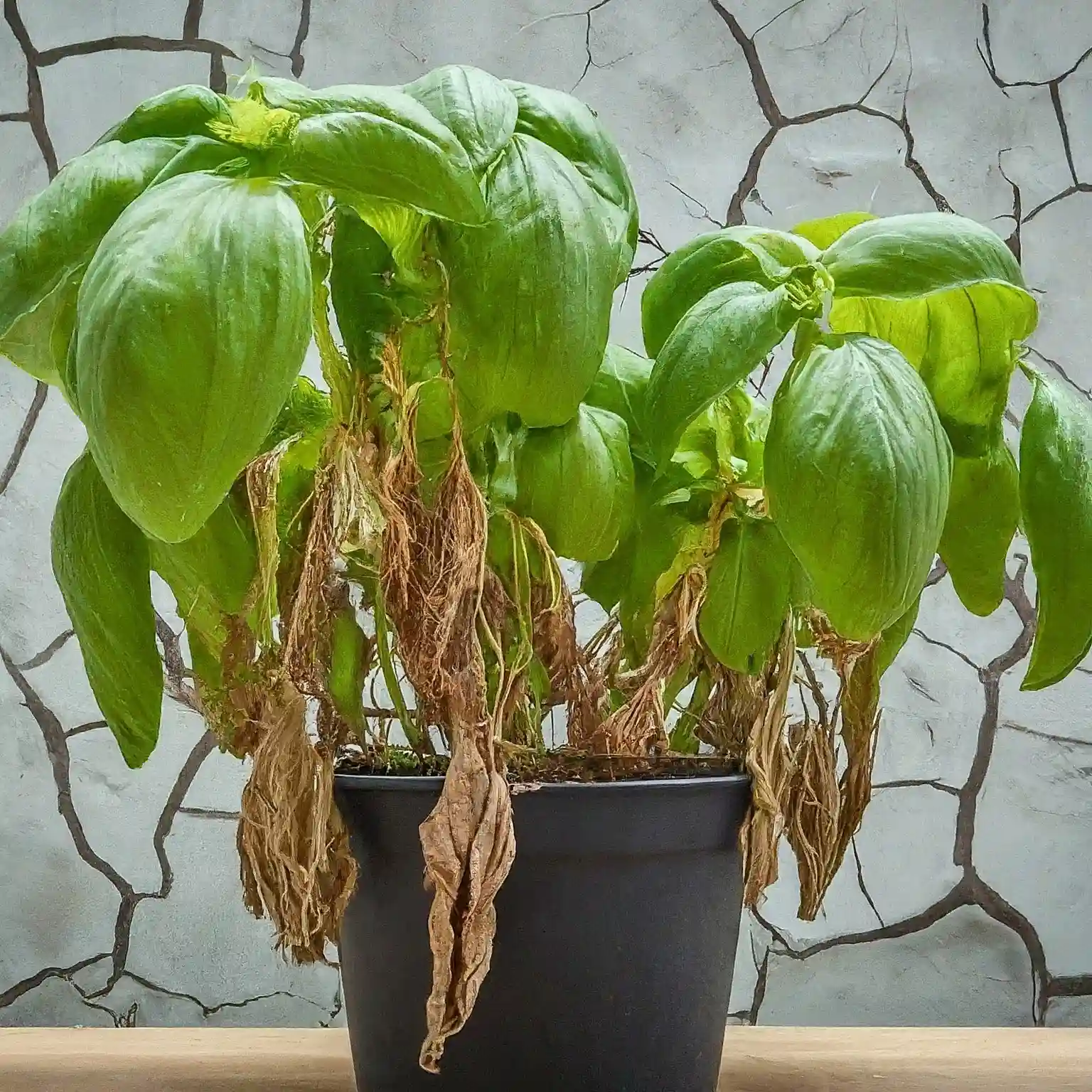How to Make Your Basil Plant Happy Again
Do you love basil? Do you have a basil plant that looks sad and droopy? You are not the only one! Many people wonder “why is my basil plant wilting?” and want to help it. Don’t worry, you can still save your basil and enjoy its smell and taste. You just need to learn what your basil plant needs and how to make it happy.
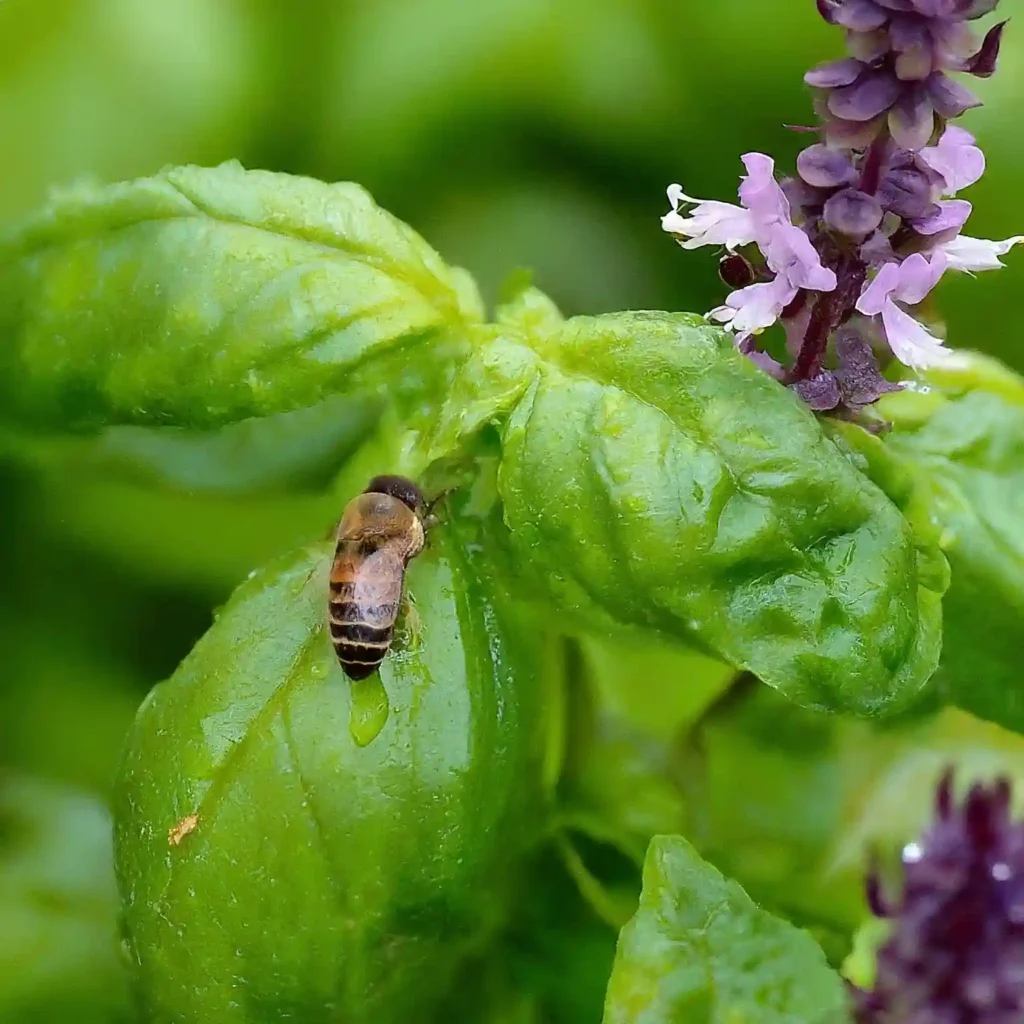
Basil is a wonderful herb that can make many dishes more delicious. It should be green and healthy. So, let’s find out what is wrong with your basil plant and how to fix it. We’ll look at the nine most common reasons why your basil plant wilts, from not enough water to too much heat, and teach you how to solve them. Then, you can have a beautiful basil plant again (and make some yummy pesto!).
Reason #1: Not Enough Water – Basil Falls When It’s Thirsty
One of the most important things for your basil plant is water. Just like us, basil plants need water to live. But sometimes, even if you water your basil plant regularly, it might not get enough water. Here’s why:
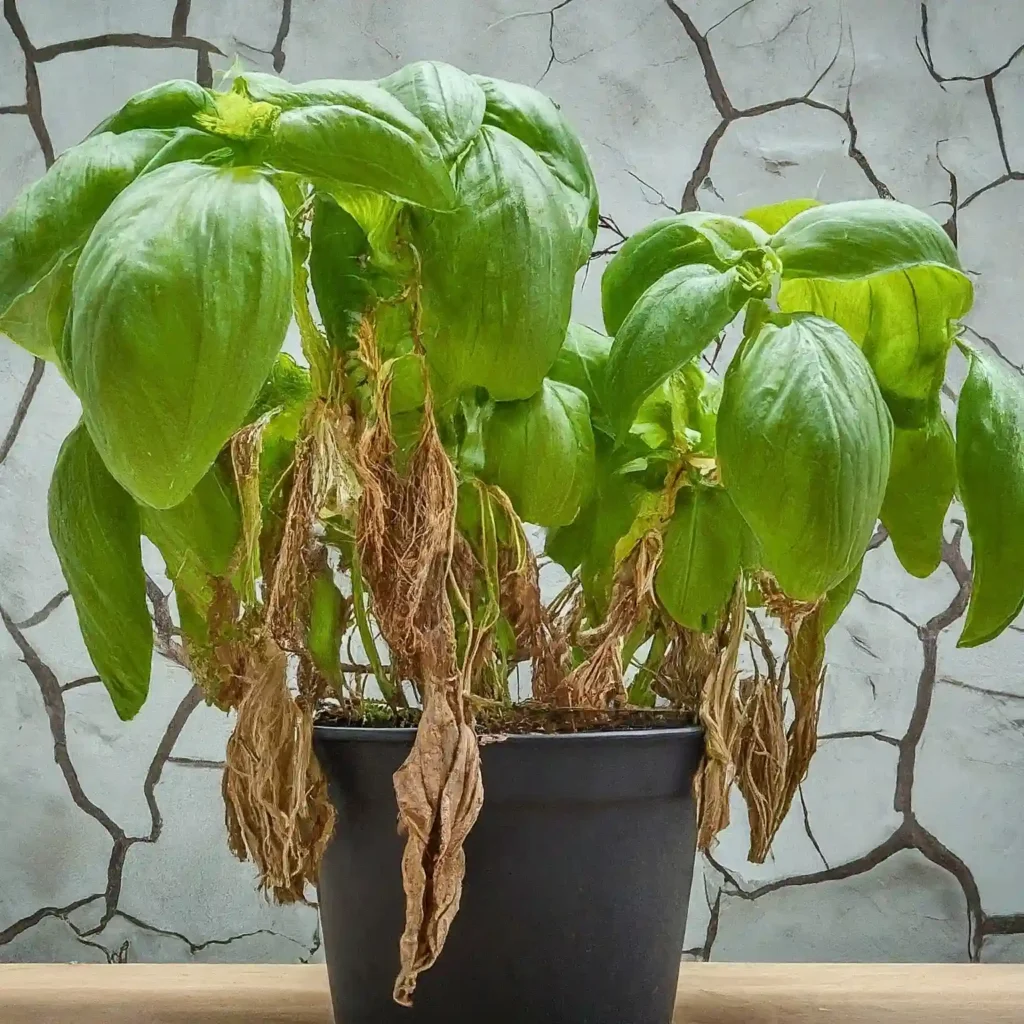
What Happens When Basil Doesn’t Get Enough Water:
- Droopy Leaves: When basil doesn’t get enough water, its leaves get soft and wilted. They look like they are tired and need a nap.
- Curly and Spotty Leaves: Not getting enough water can also make the leaves curl up and get yellow or brown spots. They look like they are sick and need help.
- Dry Soil: The first sign of not enough water is usually the soil. If the soil feels dry and crumbly, even a little bit below the surface, it means your basil plant is thirsty.
How to Tell If Your Basil Needs More Water:
There is a difference between not enough water and too much water, so before you water your basil plant, check the soil. Put your finger in the soil about an inch deep. If it feels very dry, your basil plant needs more water. Remember, the soil should be moist but not wet.
How to Give Your Basil More Water:
Now that you know your basil plant needs more water, let’s give it some:
- Water Well: Water your basil plant until you see water coming out of the holes at the bottom of the pot. This way, you make sure the water reaches the roots, not just the top of the soil.
- Check the Soil: Don’t let the soil get too dry between waterings. Put your finger in the soil every few days to see how wet it is.
- Use Mulch: Put some organic material, like leaves or straw, around the base of your basil plant. This will help keep the soil moist and cool. It’s like a blanket for the roots.
Remember: Too much water can be bad for your basil plant too. Always water less rather than more, and increase the amount of water slowly if needed. By knowing how much water your basil plant needs and following these tips, you can keep it happy and healthy, and avoid wilting problems.
Bonus Tip: You can also use a special pot or planter that has a water indicator. This will tell you when your basil plant needs water and make it easier for you.
Reason #2: Too Much Water – When Good Intentions Lead to Soggy Problems
We love our basil plants and want to take good care of them. But sometimes, we give them too much water and that makes them unhappy. This can make them wilt and look sick. The problem? Too much water. Yes, just like eating too much pesto (yummy, but maybe not so good for you…), too much water can hurt your basil. Let’s learn more about this common problem:
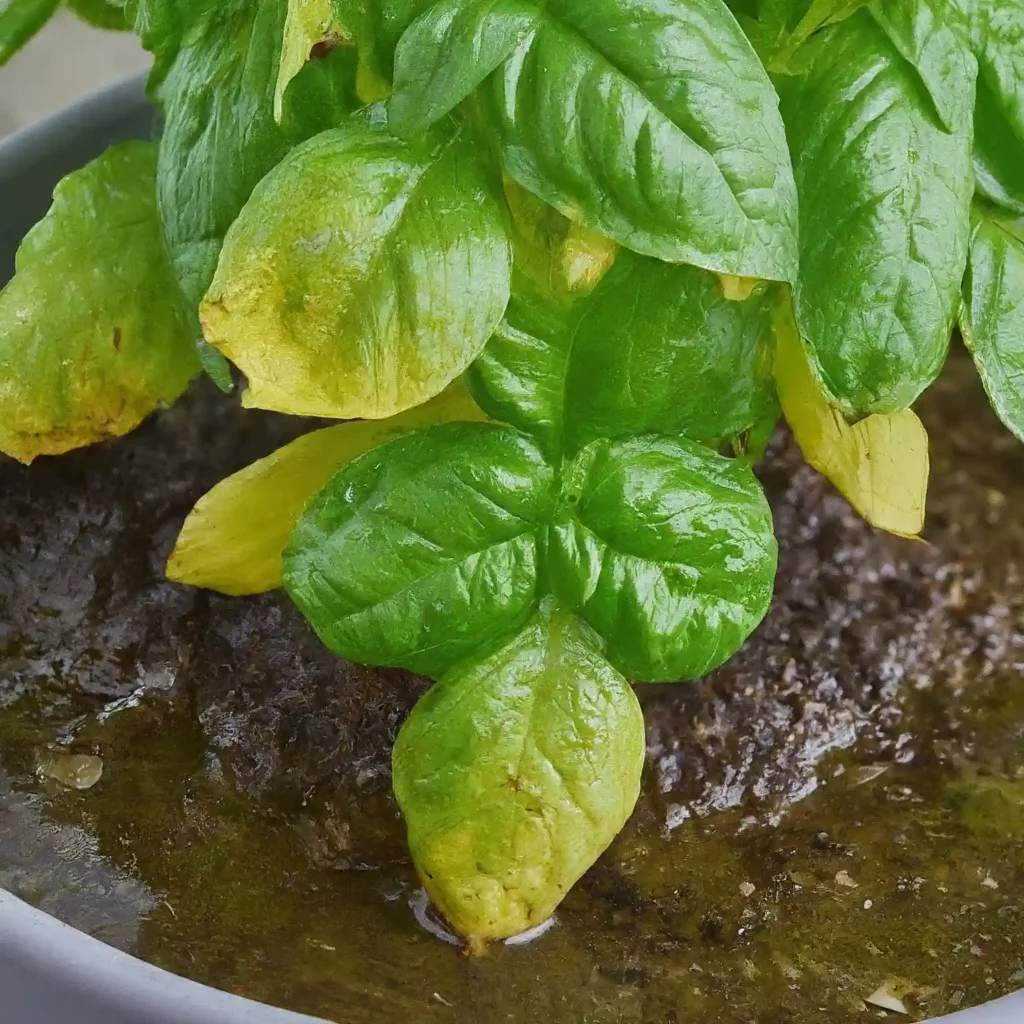
Too Much Water:
- No Air for Roots: When basil gets too much water, its roots can’t breathe. Think of them being stuck under a lot of water. This makes the roots die and the plant hungry, making the leaves wilt.
- Yellow Leaves: Too much water often makes the leaves turn yellow, especially near the bottom of the plant. It’s like your basil saying “Help, I can’t breathe!”
- Wet Soil: Another sign is wet soil that feels heavy and sticky, even after many days of watering. It’s like a muddy pond for your basil’s thin roots.
How to Tell If Your Basil Has Too Much Water:
Before you water your basil plant, check the soil wetness. Put your finger in the soil about an inch deep. If it feels wet and dirty, don’t water it. Remember, basil likes moist, not wet, soil.
How to Help Your Basil With Too Much Water:
If you think you gave your basil too much water, here’s how to make it better:
- Holes in the Pot: Make sure your pot has holes at the bottom to let extra water out. No holes means your plant is trapped in water!
- Water Less: Water only when the top inch of soil feels dry. Watering a lot at once is better than watering a little often, as it makes the roots grow deeper.
- Dry the Soil: If the soil is very wet, take the plant out of the pot and let the soil dry for a few hours before putting it back in new, dry soil.
Remember: Too much water can also make your plant sick with rot and fungus. If you see brown, soft roots or white fuzz on the soil, do something fast to save your plant.
Reason #3: Temperature disturbance – when basil feels hot (or cold).
Basil is a tricky plant. It likes to be warm like in the Mediterranean, but why is my basil plant wilting when the weather changes? The reason is that basil is very picky about temperature. Just like Goldilocks and her soup, basil wants things “just right” when it comes to hot and cold. Let’s see what temperature problems can make it wilt:

Temperature:
- Too Hot: Basil likes warm temperatures (around 21-27°C), but too much heat can make it wilt, especially when the sun is very bright. It’s like your plant got a sunburn and needs some shade!
- Too Bright: If your basil wilts mostly during the hottest time of the day, too much heat is probably the problem. It’s like your plant is losing too much water because of the strong sun.
- Too Cold: While basil likes to be warm, it doesn’t like to be cold either. Cold nights or sudden frosts can make it wilt, grow slowly, and even hurt the leaves. It’s like your plant got a cold and needs some warmth!
How to Tell If Your Basil Has Temperature Problems:
Think about the weather when your basil starts wilting. Is it wilting when the sun is very hot? Has it been very cold lately? By knowing when the wilting happens and what the weather is like, you can figure out the cause.
How to Help Your Basil With Temperature Problems:
Once you know the temperature problem, here’s how to make your basil happy again:
- Shade: If too much heat is the problem, give your basil some shade during the hottest time of the day. It’s like giving your basil a cool hat to rest under.
- Place: Pick a place with morning sun and afternoon shade for the best temperature balance. It’s like finding a nice spot with sun and shade for your plant.
- Get Ready: If moving your basil outside, get it used to cooler temperatures by putting it outside for a little bit each day for a week before planting it for good. It’s like helping your basil get ready for a new place before moving there.
- Cover: If cold weather is the problem, cover your basil with a cloth or take it inside on very cold nights. It’s like giving your basil a warm coat to keep out the cold.
Remember: Keeping the temperature steady and protecting your basil from too hot or too cold is important to stop wilting from temperature changes. With some care, your basil will enjoy the sun (and not mind the cold!) in no time.
Reason #4: Light shade – when basil craves the sun (but not too much).
Sunlight is what makes your basil grow and taste good. But, just like everything in life, too much or too little is not good. So, why is my basil plant wilting even if it seems to get enough sun? The reason may be that the light is not right, either too bright or too dark. Let’s learn more about light and how it affects your lovely herb:

Light:
- Sun Lover: Basil likes 6-8 hours of bright, but not direct, sunlight every day. It’s like it needs a lot of sunshine to make its leaves yummy.
- Thin Stems: Not enough light makes the stems long and thin and the leaves pale. It’s like your basil is trying to find the sun but getting weak and skinny instead.
- Burnt Leaves: Too much direct sun in the middle of the day can burn the leaves, making them wilt and get brown spots. It’s like your basil got a sunburn and needs some shade.
How to Tell If Your Basil Has Light Problems:
Look at your basil’s place and how much sun it gets during the day. Is it in a dark corner? Is it in the sun all day? By knowing how much light it gets, you can find the problem.
How to Help Your Basil With Light Problems:
Once you know the problem, here’s how to change your basil’s light:
- Sun Lover Tips: If your basil needs more light, move it to a brighter place or use a special light to help it grow. It’s like giving your basil a nice place to sunbathe.
- Shade Tips: If too much direct sun is the problem, give your basil some shade during the hottest hours. It’s like giving your basil a cool hat to keep it from the strong afternoon sun.
- East is Best: Windows that face east are good for giving bright, but not direct, sunlight in the morning. It’s like picking the best window with a soft morning light.
Remember: Having the right amount of light is important for your basil to grow well. By watching your plant and moving it or using extra light, you can make sure it gets the sun it needs to be happy and avoid wilting.
Reason #5: Bugs and Fungus – When Tiny Invaders Threaten Basil Bliss
Gardening is fun! Green plants, fresh herbs… then you see: why is my basil plant wilting even though you take good care of it? The problem could be hiding under the leaves – bad bugs and fungus that want to hurt your basil. Let’s learn more about these small enemies and how to keep your basil safe:
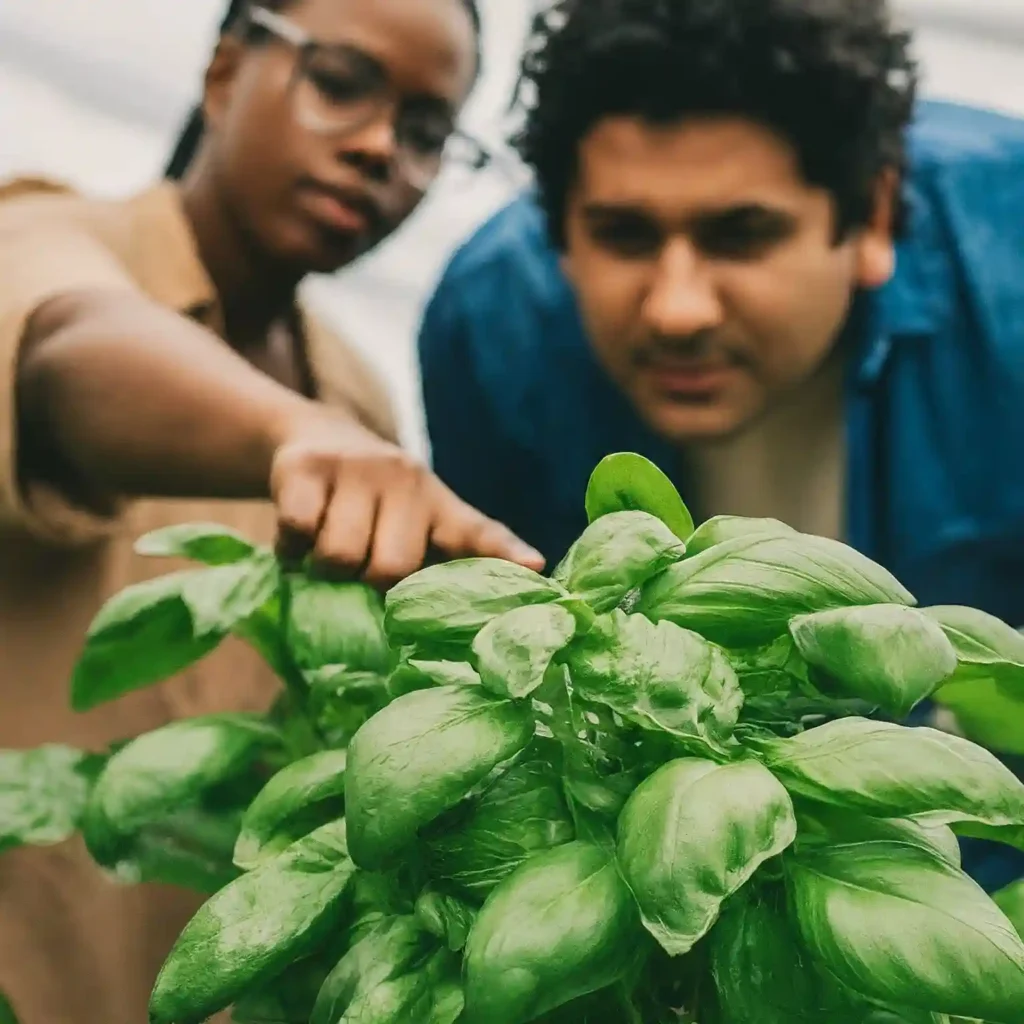
Bugs and Fungus:
- Yummy Smell: Basil’s yummy smell brings many bugs, like aphids, spider mites, and whiteflies. They think your plant is a good snack!
- Holes and Spots: These hungry bugs eat the leaves, making holes and spots on them. They make your plant look bad and messy.
- Fungus Trouble: Fungus like fusarium wilt and downy mildew can also make your basil wilt, turn yellow, and grow slowly. They make your plant sick and weak.
How to Find the Small Enemies:
Look at your basil leaves and stems for signs of bugs like small insects or sticky webs. Look for yellow, holes, or white powder on the leaves. By finding the exact enemy, you can pick the right way to fight it.
Basil Protectors Unite!
Here’s how to help your basil fight against bugs and fungus:
- Good Bugs: Bring good bugs like ladybugs and lacewings to eat the bad bugs. They are your plant’s friends!
- Good Sprays: Use soap or neem oil sprays to kill the bad bugs. Remember, use natural sprays to keep your basil (and your pesto!) safe.
- Good Cleaning: Take away sick leaves and dirt to stop fungus from spreading. It’s like keeping your plant’s home clean and neat.
- Good Space: Make sure there is enough space between plants and enough air to stop fungus from growing. It’s like giving your basil enough room to breathe and be healthy.
Remember: Stopping the problem before it starts is important! Check your plants often, keep them clean, and use natural sprays when you can. By making a healthy place and doing things early, you can keep your basil safe from bad bugs and fungus and keep it happy, free from wilting problems.
With some attention and these helpful tips, you can become a basil protector, keeping your plant safe from bugs and fungus, and making sure it keeps making your garden and kitchen smell and taste good.
Reason #6: Nutrient Needs – When Basil Craves a Balanced Diet
Just like us, plants need food to grow well. So, why is my basil plant wilting even if it seems to have everything else it needs? The reason might be that it is hungry – it needs more food inside it. Let’s learn more about the food basil needs and how to make sure it gets enough:
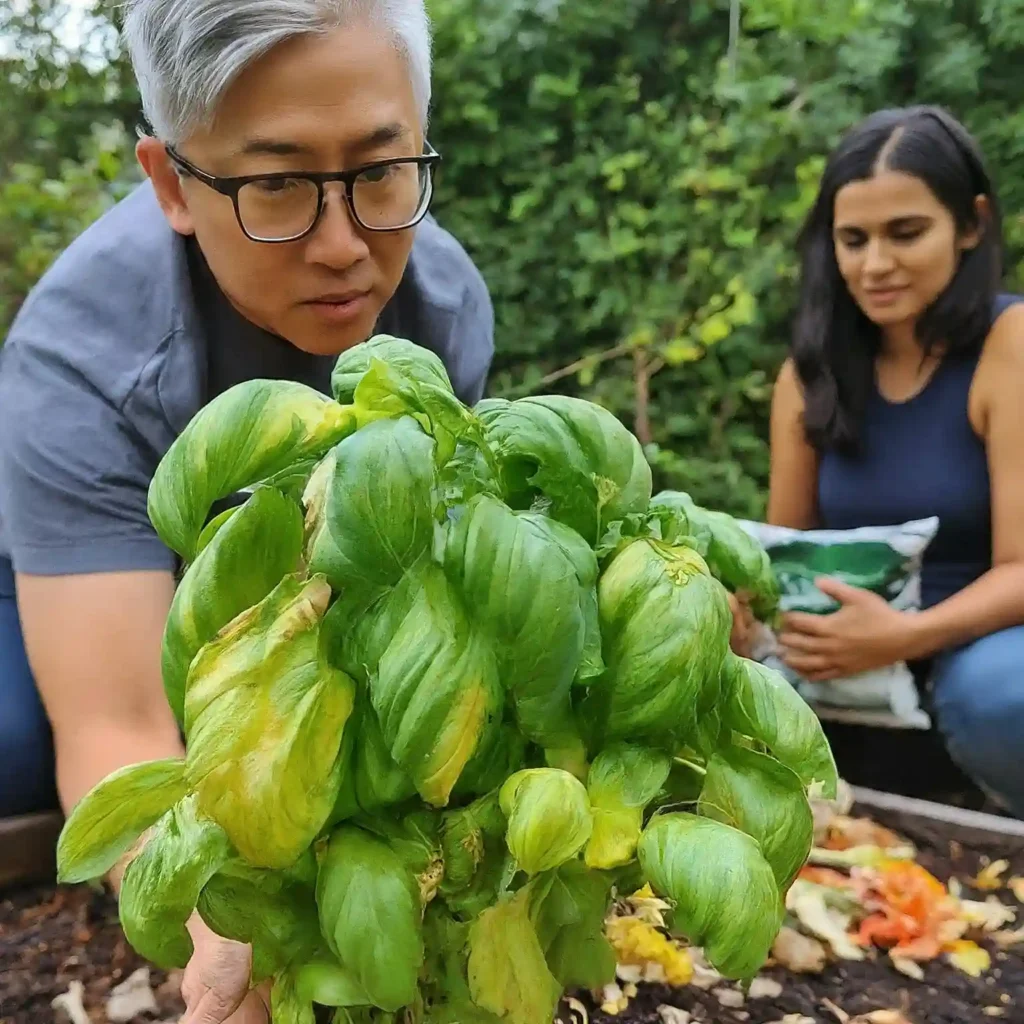
Nutrient Needs:
- Growth Food: Basil needs a mix of big food (nitrogen, phosphorus, potassium) and small food (calcium, magnesium, iron) to grow strong and healthy. They are like the vitamins and minerals that keep your plant happy and green.
- Small & Pale: When it doesn’t get enough food, basil might show signs like small growth, pale leaves, or weird shapes. It’s like it can’t grow as well as it should, like a child who doesn’t eat enough food.
- Yellow Leaves: Yellow leaves, especially on lower branches, are often a sign of not enough nitrogen. It’s like your basil losing its green color, the thing that helps it make food from the sun.
How to Find the Food Problem:
Look at your basil’s health and any signs like small growth, pale leaves, or yellowing. Think about the soil it grows in and how often you feed it. By knowing its needs and your habits, you can find the food it is missing.
How to Feed Your Basil Well:
Here’s how to feed your basil and stop future problems:
- Pick the Right Soil: Start with a soil that drains well and has a lot of organic stuff in it. It’s like giving your plant a good place to grow.
- Feed Carefully: Use a food that is made for herbs or tomatoes, and follow the directions well. Remember, too much food can be bad, so don’t overdo it.
- Compost Help: Add compost tea or old compost for more food that lasts longer. It’s like giving your basil a snack that keeps it going.
- Mulch Help: Put a layer of organic stuff around the base of the plant to keep water and stop weeds, which take food away from your plant. It’s like a shield and extra food for your plant.
Remember: Feeding often and giving the right place to grow are important for stopping food problems and keeping your basil happy and healthy. By giving it the food it needs, you can make sure it doesn’t wilt and grows well, ready to make your food taste good.
By knowing what food your basil needs and feeding it well, you can be your basil’s best friend, making sure it gets a good diet and grows without wilting. Remember, happy plants, good crops, and yummy pesto!
Reason #7: Drainage Problems – When Water Gets Trapped, Basil Drowns
Have you ever wondered why is my basil plant wilting even if you water it often? The problem might be under the soil – bad drainage. Just like humans need air to breathe, so do plant roots. When water stays in the soil and doesn’t drain, it can make the roots suffocate, leading to wilting and other problems. Let’s learn more about drainage and how to make sure your basil has happy, well-breathing roots:

Drainage:
- Root Breathing: Plant roots need oxygen to take in water and food. It’s like they need to breathe just like we do!
- Water Problems: When water stays in the soil that doesn’t drain well, it takes away air from the roots, leading to suffocation and wilting leaves. It’s like your basil is drowning in a wet pot.
- Wet Signs: Signs of bad drainage are wet soil, even days after watering, and yellow leaves at the bottom of the plant. It’s like your basil is asking for help and more air.
How to Find the Water Problem:
Put your finger an inch into the soil. Does it feel wet and dirty even a few days after watering? If so, drainage is probably the problem. Think about the pot and soil you’re using, and if there are holes at the bottom of the pot.
Drainage Solutions:
Here’s how to make drainage better and help your wilting basil:
- Pot with Holes: Pick a pot with holes at the bottom to let extra water out. It’s like giving your basil a chance to breathe!
- Good Soil: Use a soil that drains well and is made for herbs or pots. It’s like making a light and airy place for the roots to grow.
- Drainage Helpers: Add perlite, sand, or gravel to your soil to make drainage even better. It’s like adding small rocks to make air spaces and paths for water to go.
- Lift the Pot: Lift your pot on pebbles or a small stand to make drainage better, especially if it’s on a flat surface. It’s like giving your basil a little boost to stop water from staying around the roots.
Remember: Good drainage is important for stopping wilting and making the roots grow well. By fixing drainage problems and making a place for your basil’s roots to breathe, you can say goodbye to wilting problems and hello to a healthy, tasty herb ready to be used in your food.
Remember, a happy basil plant starts with happy roots! By knowing about drainage and making some changes, you can be your basil’s drainage helper, making sure it breathes well and avoids wilting, keeping your herb garden looking and smelling good.
Reason #8: Flowering Frenzy – When Basil Prioritizes Blooms Over Foliage
Seeing your basil flower feels like a gardening win, but sometimes it can make you ask: why is my basil plant wilting even if it has flowers? The reason is that the plant has different goals. Let’s learn more about the flowering time and how it can change your basil’s look:

Flower Power:
- Making Seeds: When basil grows up and flowers, it uses energy to make seeds, sometimes instead of making leaves. It’s like it wants to make more plants for the future!
- Wilting Woes: As the plant makes flowers and seeds, it might take water and food away from leaves, making them wilt a little, especially lower leaves. It’s like the leaves are less important while the flowers are more important.
- Don’t Worry: While some wilting when flowering is normal, a lot of wilting means there might be other problems like not enough water or bugs.
Finding the Flowering Problem:
Look at how much wilting there is. Are only a few lower leaves wilted, or is the whole plant droopy? Are there other signs like yellow leaves or bugs? By looking at the wilting and the plant’s health, you can tell if it’s just flowering or something else.
Making Flowers and Leaves Happy:
Here’s how to deal with the flowering time and keep your basil happy:
- Make More Leaves: If you want more leaves for cooking, take off flower buds when they show up. This makes the plant use energy to make leaves. It’s like telling the basil to stay in “leafy mode.”
- Pick Leaves Often: Pick leaves often during the growing time, even after flowering starts. This makes new growth and helps balance flower and leaf making. It’s like giving the plant a trim, making it grow more.
- Enjoy the Flowers: If you want to see the flowers and maybe get seeds for later, let some flowers grow. Remember, you can’t have your pesto and see the flowers at the same time!
Remember: Flowering is a normal part of a basil’s life. Knowing how it affects leaf making and doing some things can help you keep a good balance and enjoy both the flowers and the leaves.
With some learning and doing, you can deal with the flowering time like a basil expert, making sure your plant does well, gives you both food and beauty, and keeps being a source of yumminess and prettiness in your garden.
Reason #9: Transplant Trauma – When Moving Makes Basil Moody
Have you moved your basil plant to a new place recently, and then saw it wilting? Don’t worry, fellow herb lover! This droopiness is often a sign of moving shock, a common problem for basil plants. Let’s learn more about why moving makes basil sad and how to help your basil be happy again:
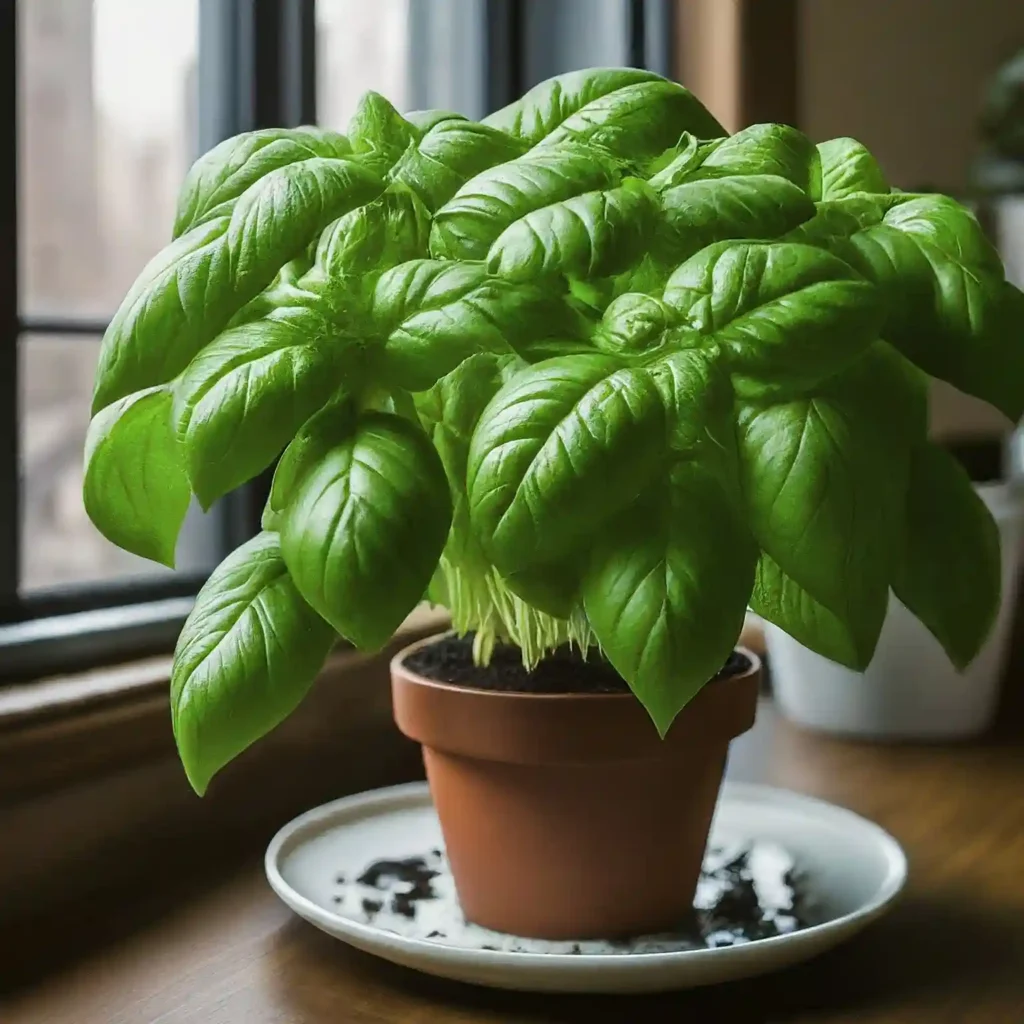
Transplant:
- Moving Blues: Moving changes a plant’s root system, making it hard to take in water and food for a while. It’s like your basil feeling tired and confused after a big trip!
- Wilting Woes: This change often makes the leaves wilt, especially when it’s hot. It’s like your basil having a hard time getting used to its new place.
- Slow Start: Don’t be sad if your basil grows slowly after moving. It may take a week or two to get better and grow faster again. It’s like your basil needing some time to relax and feel at home.
How to Find the Moving Problem:
Did you move your basil from a seed, a small pot, or another place recently? If so, and you see wilting, moving shock is probably the problem. Think about when you moved it and how healthy the plant was before the move.
How to Help Your Basil With Moving:
Here’s how to make moving easier and help your basil grow well in its new place:
- Pick the Right Time: Move your basil on a mild, cloudy day to avoid stress from very hot or cold weather. It’s like giving your basil a nice and easy welcome.
- Water Well: Water your basil a lot before and after moving to help it with the change. Remember, a well-watered plant is a strong plant!
- Get Ready: If moving outside, get your basil used to more sun and outside weather by putting it outside for a little bit each day for a week before leaving it for good. It’s like helping your basil get ready for the new weather before moving there.
- Help It Stand: Give your basil some support with a stick or a cage, especially for tall plants, to help them with wind and balance. It’s like giving your basil a friend to hold on to and grow.
Remember: Being patient is important during the recovery time. With good care and a little time, your basil will get over moving shock and give you its green leaves and yummy taste.
By knowing the problems of moving shock and following these helpful tips, you can be your basil’s moving helper, making sure it moves well and does well in its new place. Remember, a happy move means a happy harvest of fresh basil for all your food fun!
Conclusion: Basil Fun – Growing a Good Herb Garden
We learned 9 possible reasons why your basil plant might wilt, and how to fix them, from water problems to flower problems. Remember, a healthy basil plant needs good care, but knowing what it needs and giving it the right place will make you happy with green leaves and good taste.
What to Remember:
- Look: Watch your basil’s look, water habits, and place to find possible reasons for wilting.
- Find: Use the information in this guide to find the problem, thinking about when the wilting happens and what signs you see.
- Do: Do the right things for each problem, giving enough water, changing light, fixing bugs, or giving food.
- Wait: Getting better takes time, so let your basil change and get better with good care.
Basil Extra Tip: Pinch off the growing tips often to make more growth and more leaves for picking. It’s like giving your basil a trim for a bigger, more useful future!
FAQ: Why is My Basil Plant Wilting?
Q: My basil leaves are wilting, but the soil feels wet. What could be wrong?
A: While underwatering is a common cause of wilting, overwatering can also lead to wilting as it suffocates the roots. Check for drainage issues in your pot or garden bed. Ensure there are drainage holes and that the soil isn’t waterlogged.
Q: My basil is wilting in the afternoon, but perks up in the morning. What’s happening?
A: This could be a sign of heat stress. Basil prefers warm temperatures but struggles in intense midday sun. Try providing partial shade during the hottest hours or move the plant to a location with morning sun and afternoon shade.
Q: My basil leaves are wilting and turning yellow, especially at the base. What’s causing this?
A: This could be a sign of several things, including nutrient deficiency, particularly nitrogen deficiency. Fertilize with a balanced fertilizer designed for herbs and follow the instructions carefully. Additionally, ensure your basil is planted in well-draining soil rich in organic matter.
Q: My basil has flowers, but some leaves are wilting. Is this normal?
A: Yes, flowering is natural for basil, and it can sometimes cause slight wilting, especially in lower leaves, as the plant prioritizes energy towards seed production. However, excessive wilting could indicate other issues like pests or underwatering.
Q: My basil wilted after I transplanted it. What should I do?
A: Transplanting can stress the plant, leading to temporary wilting. Water your basil thoroughly before and after transplanting, and gradually acclimate it to its new environment by exposing it to increasing sunlight and outdoor temperatures before leaving it permanently.
Q: How can I prevent my basil from wilting?
A: The key is to provide optimal growing conditions. Ensure your basil receives proper watering, sunlight, and nutrients. Choose well-draining soil, fertilize regularly, and address potential issues like pests or diseases promptly.
